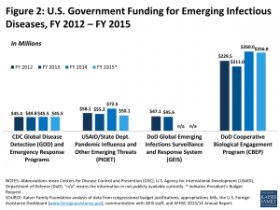Emerging Diseases

The U.S. Government & Global Emerging Infectious Disease Preparedness and Response
Emerging infectious diseases represent an ongoing threat to the health and livelihoods of people everywhere, including those of Americans. Over the last few decades, there have been several EIDs that have taken the global community by surprise and drawn new attention to EIDs, including HIV, SARs, H1N1, and Ebola. Governments, multilateral institutions, and other organizations have increasingly recognized the threat such diseases pose and have augmented global efforts to prepare for and address them; the U.S. government has been a key supporter of these activities.
Emerging infectious disease (EID): An infectious disease that is newly recognized as occurring in humans; one that has been recognized before but is newly appearing in a different population or geographic area than previously affected; one that is newly affecting many more individuals; and/or one that has developed new attributes (e.g., resistance or virulence).
Current Global Snapshot
After a period of optimism during the 1960s and 1970s about humankind’s ability to conquer infectious diseases, global concern about EIDs has grown. Since 1980, approximately one to three new human infectious diseases have been identified each year; others have “re-emerged, ” causing greater numbers of cases than before and/or affecting different populations and regions than in the past (e.g., dengue fever or Ebola), and others have developed resistance to available treatments (e.g., multi-drug resistant tuberculosis). In particular, the discovery of HIV/AIDS in 1981 marked a turning point in global consciousness about global vulnerabilities to EIDs. There are a number of factors that contribute to disease emergence – including population growth and movement, changes in land use, greater contact between people and animals, international travel and trade, and poor public health infrastructure. Many of these factors are present simultaneously in certain geographic areas that have been identified as “hotspots” for emerging diseases, such as parts of Asia and sub-Saharan Africa.,
Impact of EIDs
While not every newly identified infectious disease has major public health implications, a few have resulted in global pandemics (like HIV/AIDS and H1N1 influenza, see Figure 1). Such outbreaks have also led to significant economic losses and interruptions in trade and travel. For example, SARS precipitated up to $30 billion in economic losses (over $3 million per case) in 2003.
|
Emerging Disease |
Year Identified |
Estimated Global Impact |
|
|
Cases |
Deaths |
||
| Ebola Virus Disease |
1976 |
19, 568 |
7, 653 |
| Human Immunodeficiency Virus/Acquired Immune Deficiency Syndrome (HIV/AIDS) |
1981 |
78 million |
39 million |
| Variant Creutzfeldt-Jakob disease (vCJD or “mad cow disease”) |
1996 |
229 |
|
| H5N1 Influenza (“bird flu”) |
1997 |
668* |
393* |
| Severe Acute Respiratory Syndrome (SARS) |
2003 |
8096 |
774 |
| H1N1 (2009) Influenza (“swine flu”) |
2009 |
unknown |
284, 500 |
| Middle East Respiratory Syndrome (MERS) |
2012 |
699 |
209 |
| H7N9 Influenza (“bird flu”) |
2013 |
453 |
175 |


|
Herbal Antibiotics: Top 20 Natural Herbal Medicines and Home Remedies as Alternative Therapies for Long-Term Disease Resistance (home remedies, alternative medicine, natural antibiotics) eBooks |
|
|
Wildlife and Emerging Zoonotic Diseases: The Biology, Circumstances and Consequences of Cross-Species Transmission (Current Topics in Microbiology and Immunology) Book (Springer) |